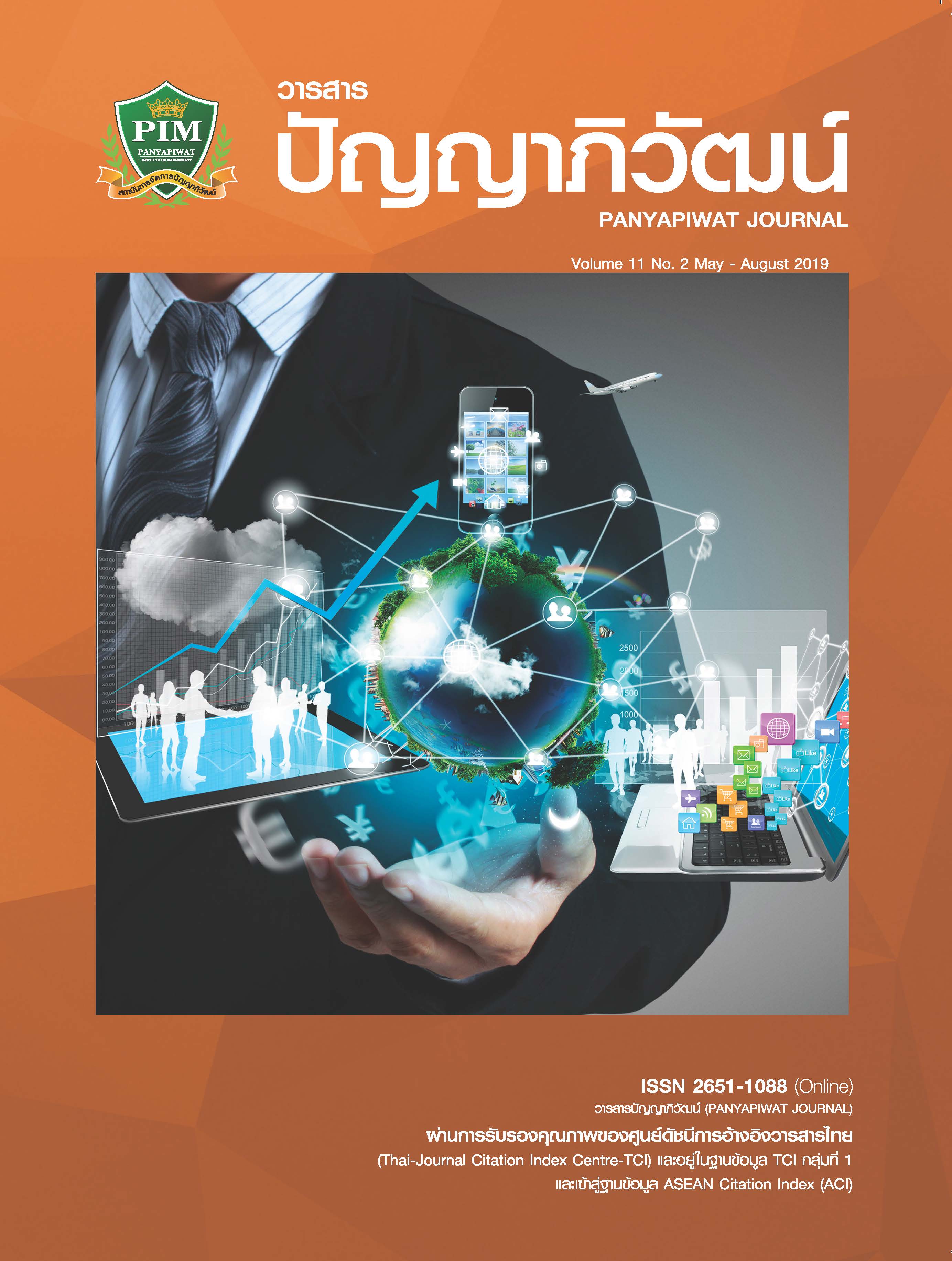THE CAUSAL RELATIONSHIP OF EFFECTIVENESS IN INFORMATION AND COMMUNICATION TECHNOLOGY UTILIZATION OF RAJABHAT UNIVERSITY LECTURERS IN NORTHERN REGION
Main Article Content
Abstract
The purposes of this research were to develop and verify a causal relationship model of effectiveness in information and communication technology utilization of Rajabhat University
lecturers in the Northern Region. The research sample consisted of 324 lecturers of Rajabhat Universities in the Northern Region. The research tool was a questionnaire with reliability coefficient of 0.95. Data were analyzed using descriptive statistics and analysis of the causal relationship model based on structural equation modeling.
Research results could be concluded as follows: The developed causal relationship model was consistent with empirical data as shown by the statistical values: χ2 = 10.801, df = 9,
p = .290, χ2/df = 1.200, GFI = .992, and RMSEA = .025 Resources management, communications and supporting activities, and executive leadership had direct effects on the effectiveness of information and communication technology utilization, with significant path coefficients of 0.63,0.20, and 0.12, respectively. Measurement and evaluation, organizational culture, and executive leadership had indirect effects on the effectiveness of information and communication technology utilization, with significant path coefficients of 0.53, 0.10, and 0.34, respectively.
Article Details
I and co-author(s) certify that articles of this proposal had not yet been published and is not in the process of publication in journals or other published sources. I and co-author accept the rules of the manuscript consideration. Both agree that the editors have the right to consider and make recommendations to the appropriate source. With this rights offering articles that have been published to Panyapiwat Institute of Management. If there is a claim of copyright infringement on the part of the text or graphics that appear in the article. I and co-author(s) agree on sole responsibility.
References
Barnard, C. (1966). The function of executive. Cambridge, USA: Harvard University press.
Brown, M. & Cudek, R. (1992). Alternative ways of assessing model ft. In K. A. Bollen, J. S. Ling (Eds.). Testing structural equation models. Beverly Hill, CA: Sage.
Byrne, B. M. (2001). Structural equation modeling with AMOS basic concept, application, and programming. New Jersey: Lawrence Erlbaum Associate.
Carty, B. & Phillip, B. (2001). The nursing curriculum in the information in the information age. In Saba (Ed.).
Essentials of computers for nurses: informatics for the new millennium. (3rd ed.). New York: McGraw-Hill.
Chandarasorn, V. (2013). The theory of public policy implementation (6th ed.). Bangkok: Prikwan Graphic. [in Thai]
Chuenwisit, C. (2002). Relationships between personal factors, ability in using computer, organization environment, and ability in using information technology for management of head nurses, governmental hospitals under the jurisdiction of the ministry of public health, Bangkok metropolis. Master of Nursing Science, Chulalongkorn University. [in Thai]
Collis, B. & Wende, V. M. (2002). Models of change: ICT and the Internationalization of higher education. Journal of Studies in International Education, 6(2), 87-200.
Cronbach, L. J. (1951). Coeffcient alpha and the internal structure of tests. Psychometrika, 16(3), 297-334.
Drucker, P. F. (1995). Innovation and entrepreneurship, butterworth heinemann, clinical information system.
Computer in Nursing, 15(2), 71-76.
Kline, R. B. (2005). Principle and Practice of Structural Equation Modeling. New York: The Guilford Press.
Krothe, J., Pappas, V. & Minnick, L. (1996). Nursing students use of collaborative-computer technology to create family and community assessment instrument. Computer in Nursing, 14(2), 101-107.
Mapangmo, S. (2012). Relationship between full leadership of school administrators with the information technology and communication management of the schoolunder the offce of the secondary education service area 21. Nakhon Phanom University, 2(1), 101-108. [in Thai]
Marasovic, C., Kenny, C., Elliot, D. & Sind-husake, D. (1997). Attitude of Australian nurse toward implementation of a clinical information system. Computer in Nursing, 15(2), 71-76.
Middieton, P. (2002). Barriers to the effcient and effective use of Information Technology. The International Journal of Public Sector Management, 13(1), 85-99.
Ministry of Education. (2014). Master Plan for Information and Communication Technology for Education. Ministry of Education, 2014-2016. Retrieved October 10, 2015, from https://drive.google.com/fle/d/0B8hb_xCL9LsPazcyNVg4WHZQUTA/view [in Thai]
Ministry of Information and Communication Technology. (2014). Master Plan for Information and Communication Technology No. 3, 2011-2020. Retrieved October 10, 2015, from https://www.oic.go.th/FILEWEB/CABINFOCENTER3/DRAWER088/GENERAL/DATA0000/00000498.PDF [in Thai]
Narapong, V. (1999). Personal factors, environmental support in using computer, ability of computer utilization of nursing instructors in nursing colleges under the jurisdiction of the ministry of public health. Master of Nursing Science, Chulalongkorn University. [in Thai]
National Science and Technology Development Agency. (1997). Annual Report 1997. Bangkok: National Science and Technology Development Agency. [in Thai]
Phunumkang, C. (2005). Information and Communication Technology Needs for Agricultural Extension Workers in the Northeastern Region. Master of Science, Khon Kaen University. [in Thai]
Schein, E. M. (1990). Organizational Culture. American Psychologist, 45(2), 109-119.
Schumacker, R. E. & Lomax, R. G. (2004). A Beginner’s Guide to Structural Equation Modeling (2nd ed.). New Jersey: Lawrence Erlbaum Associates.
Seammai, N. (2011). A Study of Adoption of e-Government Information Technology (G2E) of Service Level Offcials Case Study: Offce of the Permanent Secretary, Ministry of Interior and Offce of the Permanent Secretary, Ministry of Information and Communication Technology. Master of Science, Thammasat University. [in Thai]
Seenuankaew, S. (2010). Success factors to ICT use for social development to quality society in developing countries. Academic Resource, 21(2), 126-138. [in Thai]
Senge, P. M. (1990). The ffth discipline: the art and practice of the learning organization. New York: Doubleday.
Stevens, J. (1986). Applied multivariate statistics for the social sciences. Hillsdale, NJ: Lawrence Erlbaum Associates.
Teawchanteuk, S. (2000). The knowledge and skills of nurses in utilizing information technology for work in community hospitals in the central region. Master of Nursing Science, Mahidol University. [in Thai]
Wangpipatwong, T. (2007). Application of ICT for Education. Bangkok: Bangkok University. [in Thai]
Whittaker, R. H. (1975). Communities and ecosystems (2nd ed.). New York: Macmillan.
Wongwanich, V. (2012). Organizational Factors in Knowledge Management Affecting Knowledge Management of Information and Communication Technology in Schools under the Offce of Secondary Education Region 10, Phetchaburi Province. Silpakorn Educational Research Journal, 4(1), 237-246. [in Thai]


